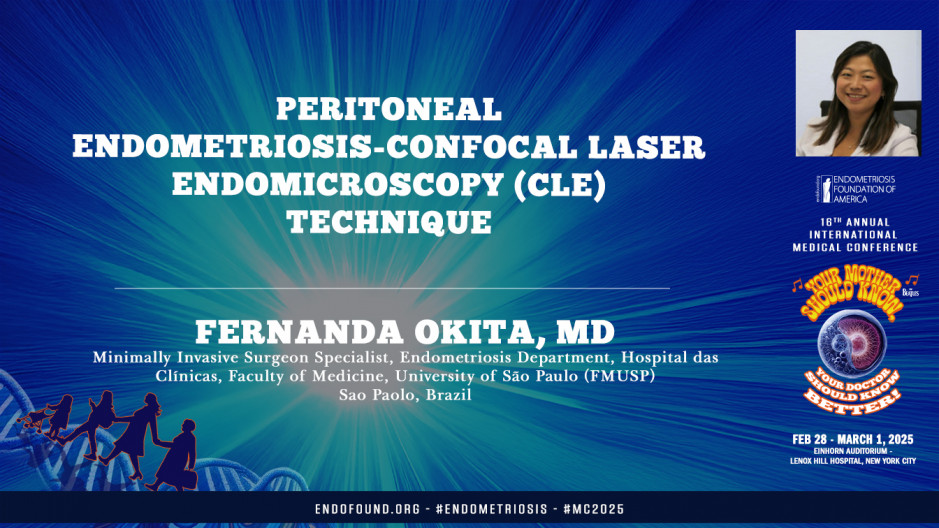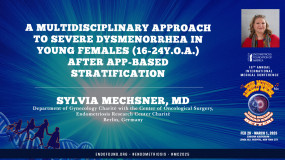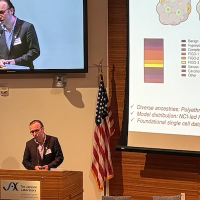International Medical Conference Endometriosis 2025:
Endometriosis 2025: Your Mother Should Know, Your Doctor Should Know Better!
Peritoneal Endometriosis-Confocal Laser Endomicroscopy (CLE) Technique-Fernanda Okita, MD
Our next speaker is Dr. Fernanda Okita. She is a gynecologist and obstetrician specializing in minimally invasive gynecologic surgery and endometriosis. She serves as a medical collaborator in the endometriosis sector at Hospital Clinicas University of Sao Paulo, and is the chief associate of the fellowship in minimally invasive surgery endometriosis at and urogynecology at Benefic Sensia Portuguese de San Paolo in 2023, Dr. Okta was honored with the Ruth Sontag New Andwe Award recognizing her significant contributions to women's health and medical science. Welcome Dr. Okta.
Hi, good evening. Thank you for having me here for the organization to inviting me to be here today. So I'm here to speak to you about the confocal lasering, the microscopy, which was my master thesis. It's very interesting to see a microscopic view in vivo. So that's what I'm going to show you. And it was made with the orientation of my professor Mari in Sao Paulo. So here in the first slide you can see these probes there. They are not made for laparoscopy. They were all for another issue. So I'm going to show you how we did to use it in laparoscopy and what we achieved in this. So just to point out, we were talking about the interpretive navigation in endometriosis, but if we think about the general surgery we here in the microscopic view, and that's where confocal laser and microscope is.
So this story started in 19 19 57 with Marvin Minsk that developed a confocal that's like a conjunction of lenses that can provide us parallel image that's underneath the tissue and how we can see here. So it's a optical biopsy and this was the device that we used. There are a lot of other devices, but this was the one that we used. So when we do the laparoscopic to analyze this, we use the laparoscopic monitor and besides we have the confocal monitor. And if you're using in robotic surgery, we also use the Tau Pro device so we can see both of them in the same screen. So normally what we do is to do a normal biopsy and it can causes of course bleeding and even perforation infection and something like this when you do the normal biopsies and it also increases the cost of the surgery.
If you think about the delay of the histopathological result, I mean we analyze everything that we take off, but we don't analyze what it stays inside and that's what we want to change during the optical biopsies. So with this we can have a topographic view of all the sections that we want to analyze and have a more specific and more to see all the endometriosis in the places that we don't even know if we are living behind or not. So in order to have these images, we have to use a dye. So it's an int venous dye that we use in the patient more or less 10 minutes before we analyze the confocal. It's a very safe dye, so it's easy for us to use it there and that's why we chose to keep on using like this. So the P-O-C-O-E, that's the confocal laser end microscopy is, I think it's better for me to talk like this because it's very long. So the PCOE, it's not like a new thing. It's also used in gastroenterology, especially when we think about the, let me just show again here.
They use a lot for Barrett Zofigo for seeing the healthy intestinal mucosa, but it's also used in bronchoscopy and in cholangiography. So there are many, many other fields that are using this already, but in laparoscopy they were not used at this point. So why did we think about using this for endometriosis? Because we know that's a very diverse disease. So we have a lot of issues with our patients in order to their quality of lives. And especially talking about the surgery itself. We have some challenging situations that we have to consider that's about the extent of the disease. So we have to manage the ality in all these patients and looking for preserve their fertility and also to improve their quality of life. So with all this, our goal is to avoid reoperation of this patient that we know that's very, very common to happen.
So that's why we trying to use new technologies to diagnose it better as the confocal laser endo microscopy. And our goal is to identify the suspicious lesion in real time at cellular level and also differentiates from other pathologists that can happen to check the presence of a fibrosis that we could see also in confocal all of this to try to remove all the endometriosis as at a cellular level as we will always want to do. Normally what we do is to use our eyes to see the endometriosis. I think there's no, not everybody can see that this is endometriosis, but we have the definite diagnosis with histopathology after. So what we were looking at when we started this project was to see if we could see this image here in the confocal. So wait, okay, so here we have this logic structures that we're looking for. It's the ECT endometrial gland here, and it's surrounded by ectopic end endometrial with stroma. And also we have some macrophages with edine around this.
So then we started this study. This is a pilot study that was published last year. We have the care code here if you want to look a little bit about this a little bit further for this study. And this is the hospital that we made the study. This is Maria Hospital and we did it in partnership with the University of Sao Paulo Hospital. That's how, wait, lemme see. Okay. So that's how we applied the probe inside the laparoscopy. So we tried different devices, different probes, actually they have different diameters to pass it through the normal tissue and also the endometriosis tissue to see what we can see there. And then after we could pair them with the iStop pathological images. So that's what we see when we are passing through during the miosis. We see all these black points there that we found out that this is trauma. Of course we have some dirtiness that is keeping in the screen, but we can differentiate because we are passing all this probe through the peritoneum so we can see what we could compare what is thirdness and what is the structures.
So I brought another images for you to understand and you have the ovarian tissue in this first video. And here we have another thing that's very interesting that's developed vascularization also. And also here we have a little bit of stroma and some debris that was inside with some fibrosis. So we were able to capture 214 optical biopsies with this work. So we could compare and make an atlas of this so we could understand if we're seeing this and how the structure in confocal manner. So in this comparison, we saw here that you can see, oh, sorry.
Okay, so in this comparison we can see here what we see in the laparoscopy and how is the evaluation of this area and compared this with a video that was, and the optical biopsy that we arranged in the confocal. So we can see here that there's a lot of stroma, but the glands are a little bit harder for us to see. But in some images, in some biopsies we could see it also very clearly another picture here. So we can see also the edine and debris. And also here we have some STR that we could correlate with the top pathological images. Also here we have stroma that's a little bit more loose and we could manage to compare this image. You see that's very similar. And another thing that was very interesting for us to see is the fibrosis. We can see here the fibrosis in the osteo pathological image here and this trauma beneath this. And also here we see the same image like with the fibrosis and saw the aspect of the optical biopsies that we saw in our study.
So with this, we developed this atlas. So we compared first the histology and the optical biopsies for different structures. So here we have the stroma and also stroma and glands. We can see some glands around here and some macrophage and rrh and C around them here also, we have the fibrosis as I showed before. And one thing that was very interesting for us to do it in real time was that we could see the vascularity of the spasm, that something that we cannot see when we take off and do the histology analysis after the surgery. The deposits are very, very easy to see. And also here you can see a little bit of them.
So we also pass the confocal and against some images for the normal parts, what we visually thought that it was normal. So here we have the ovary so we can see that you don't have this black dots any part. Also in peritoneum it's very, very different from where we see the endometriosis here. Also, all these places that are normal, we cannot take it all to analyze, but we try to gain the most images that we could get. And here also, especially in the uterosacral ligament, is very beautiful to see actually, because the uterosacral ligament always has this aspect when it's normal and every time we see, oh, there's a trauma around the uterosacral ligament. When we pass the confocal also here, when we see the mear rectum that's here and here is the intestine here, we can see the difference between them. And here in the mear rectum and endometriosis is starting, we can see this str is starting to appear in this place.
So what we did was to understand what we were seeing was reproducible. We have some people could see the same things that we were doing here. So we asked many surgeons to see this atlas and use the atlas to respond if they have endometriosis in general or if they have glands and stroma and all the issues that we could find. And what we could see, first we asked them if they had already seen the confocal laser end, the microscopy before, and the ones that had had contact before with this, they could see a little bit better the glands that was very hard to see, but they could see better glands, they could see better fibrosis, they could see better macrophages.
There was no difference between the ones that had contact before and the person that was seeing for the first time for endometriosis in general or trauma that was easier to achieve. So what we see that in general, they have the same similar general accuracy to detect the endometriosis. So we see that we have a consistence of the results and the previous training of confocal didn't have any impact in the results of the study. Another thing that we could see is here with the, yeah, also, sorry, sorry it came back. Yeah. Okay. So when we think about the histological structures, we see that there was more than 80, like 18, 10, right? Responses for endometriosis in general is trauma adipose and vascularization and a little bit less for gland fibrosis eding. But in the right questions were writing seven point 95, almost 8%, 80% of the cases.
Also here we can see, so the endometriosis in general, that's what we actually aiming for, is not to understand the pathology of the structure, but if there is endometriosis in that tissue that we're living behind or not. So we have a very high quantity of the right answers, but the overall, when we consider the different structures is a little bit lower. But as I said before, our principal goal was to understand D endometriosis was seen and people were able to see the same things and to understand if there's endometriosis in this tissue or not. So we concluded that there was a high identification of endometriosis in all of this. So as a conclusion of all this, the confocal was this work, this pilot study was the first one that we used in the gynecology and also actually in laparoscopy there was not, I think, no just one work before using in laparoscopy, but it was the first one to describe endometriosis.
And that I think is a great gain that we did, especially when we did this atlas that was very interesting for a lot of people to understand and to see and to try to learn a little bit about this technique. Also, what we think is that with the continuous of this work, we can improve the clinical practice as we have the immediate diagnosis of endometriosis. So in vivo we also can see if we are living really behind and not having this doubt if we live behind the endometriosis. And also we can reduce the operational costs of all of this because we trying to benefit the patients reducing the need of new surgeries in the future. So we think that the more accurate identification of the lesions can lead us to less reoperation and also to improve their fertility.
And the great thing about after we doing this study with the other surgeons was the consistency in this diagnosis. So it was great to see that it didn't demand many practice to identify the same thing that we were seeing. So we don't have to have a pathologist in the OR for identify for us, since we studied just a little bit the atlas, we can understand where's this trauma or not and where's the endometriosis in the confocals. So it was very, very interesting for us that we could see that different professionals in different area that study endometriosis, they could find out the same thing as we did before. So I want to thank the endometriosis foundation for remembering us in Brazil is representing here. Also my team, but also my country here. I'm with Professor Mauricio that's here. He's my professor for a long time. And he and myself developed this idea. And also this is he, that was our pathologist that was with us in this work. Thank you.










